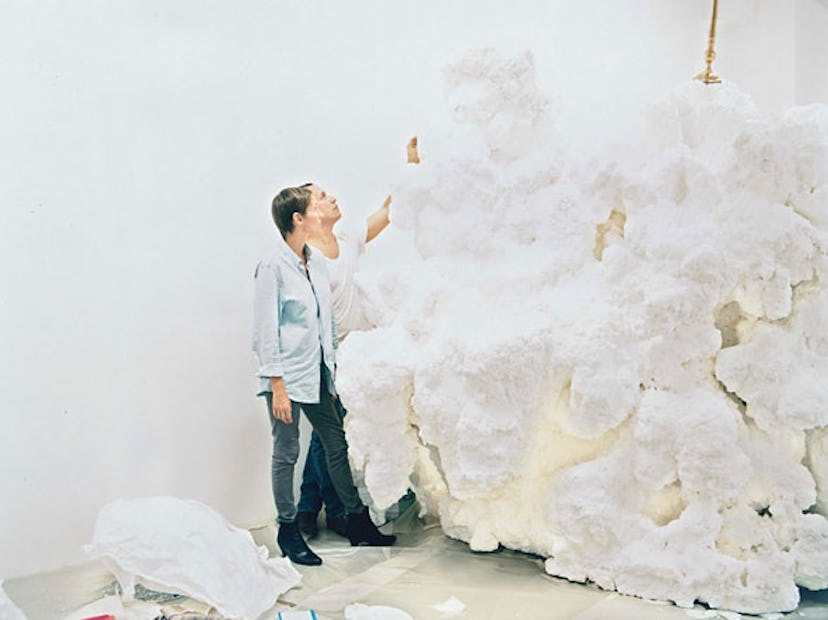Two For One
In an age of outsize egos, some artists have chosen to pair up to present a single, seamless vision. Linda Yablonsky reports on today’s talented twosomes.

The notion that the best art can only come from a single artist working alone is something of a myth. Take the six people in the double portraits here. They actually add up to just three artists, each with two surnames: Allora & Calzadilla, Fischli and Weiss, and Elmgreen and Dragset. If that makes them sound like classic comedy teams in the Burns-Allen, Martin-Lewis, Abbott-Costello mold, it is probably no coincidence. Humor and performance play prominent roles in their art. It’s just that they’re not so visible in it.
Comedic twosomes’ punch-and-parry routines depend on their individual differences; the right hand needs a left to shake. Likewise, these artist duos work solely as teams, and project a sensibility the partners share so deeply that they can articulate it only by combining forces. Though they identify themselves as individuals, none have separate solo careers or, in the case of Allora and Calzadilla, who are a couple, separate lives. In their sculpture, photography, books, films, and live-performance pieces, they work and speak as one.
In fact, it is common today for artists to team up with others—because the studio can be a lonely place and, well, because two heads can be better than one. But when solo artists collaborate on specific projects, like the paintings Andy Warhol and Jean-Michel Basquiat did in the Eighties, it’s easy to tell who did what. Not so with this bunch. The seams in their art never show, and seldom is it clear that we are seeing the world through four eyes instead of two.
There are hints, as in the double-exposed flower and mushroom photographs by the Swiss duo of Peter Fischli and David Weiss. They met in Zurich in 1977 and soon started making photographs featuring a pair of sausages. The artists worked so well together that two years later they began a series of deadpan videos in which they appeared—masked and in costume—as a rat and a panda. One video, “The Right Way” (1983), led to 2002’s comically imponderable Questions (“Will happiness find me?” “Why are there bad people?” “Who’s going to pay for my beer?”), which was both a slide show installation and a book. Occasionally, during the 13 years it took to make “Visible World”—a compendium of 3,000 color snapshots from nearly every point on the globe—the pair traveled separately. But that was after they spent several years in a studio making their suspense-filled, surprise-hit 1987 video, “The Way Things Go,” in which worthless objects colliding in an epic chain reaction ultimately acquire unexpected value—as art.
The recent selection of Jennifer Allora and Guillermo Calzadilla as the artists representing the U.S. at the 2011 Venice Biennale surprised many in the art world. They are not big names yet, nor have collaborating Americans ever won that plum commission. But the duo has established an enigmatic and increasingly profound body of work that fuses personal concerns with pressing social issues like oil consumption or war, and often involves loud music. The couple met as students in Italy in 1995, and have been together ever since. “We were discovering what we liked about art together, often being interested, surprised, or curious about the same things,” they recall. “It just seemed logical to us to share.”
Their ideas flow from daily conversation, which is not always congenial. When a conflict occurs that they can’t resolve, they simply put it into the work at hand. They live with their baby daughter, Isa, in San Juan, Puerto Rico, but do not maintain a studio there or anywhere else, because they contract out the fabrication of their sculptures and hire the opera singers, musicians, and military trumpeters who appear live, embedded within their sculptures. That doesn’t mean the pair’s collaboration extends to others, however. It is their vision alone that each work projects. In a recent video shot at a gas station in Tehran, a double-humped camel girded by a giant rubber tire stands in for them, watching sadly as cars and trucks fill their tanks and drive off. “The benefit of working together,” they say, “is that there is always the other person there who, kind of like a trainer, is always pushing you further.”
Michael Elmgreen and Ingar Dragset met at a Copenhagen gay bar in 1994, and started performing together a year later—because “we naively believed that our love life was so unique it had to be of everyone’s concern.” Neither man has any formal training in art. But the objects in their absurdist “Powerless Structures” series—a statue of a boy on a rocking horse, a wooden door with staring eyes behind it—send up the art business in slapstick ways intended to keep it honest. They characterize themselves as idea men who supply the creative energy, but they leave it to their studio assistants in Berlin to do the heavy lifting—and they own whatever comes of it.
For their current show at Germany’s ZKM/Museum of Contemporary Art, Elmgreen and Dragset replicated a public housing project whose TV-watching tenants are visible through the windows. “The whole scenario depicts how we relate to a world of images that might have very little to do with our everyday lives,” they explain. “The show is called ‘Celebrity,’ but it is about loneliness.” (This from artists who never do anything alone.)
Some will say that, like any piece made by committee, such collaborations lack the subjectivity of a single artist’s viewpoint, and that this is what’s wrong with contemporary art today—it’s too impersonal. Yet Stop, Repair, Prepare was the most enthralling gallery show in New York last year. Fischli and Weiss’s works remain among the most disarming on the planet. And Elmgreen and Dragset can keep you laughing for days. And thinking.